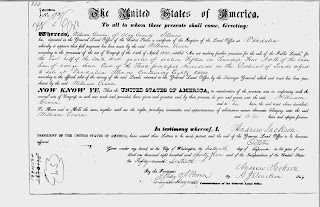In l8l5 he moved to what became Lawrence county, Indiana, just a year later when Indiana became a state in December 1816. In that county, he became widely known, serving for a time as County Judge. He was described as a ”man of fine abilities, and… integrity”. His commissions as County Judge were signed by Jonathan Jennings, as Governor of the state of Illinois, and R. A. New, as Secretary of State.
Judge William Erwin and three of his sons, Jarrett L., David and Crawford (my 3rd great grandfather), moved from Indiana, and settled in Clay County Illinois, in October, 1832. Judge Erwin, as he was known, bought his first tract of land there, 80 acres, in 1833. The Erwins were influential citizens, and did much toward building up schools and churches, and developing the county. Judge William Erwin was a member of the County Board in 1834.
The first school taught in the Hoosier Prairie was by Judge Erwin, at his own home, and attended by all in reach. Young men would also come from other neighborhoods and board in the vicinity in order to attend the school. “The school was taught by Judge William Erwin, in a log cabin in the Judge’s own door-yard, and the seats consisted of split poles with pins in them for leg's; the floor was of puncheon, and the window was simply a log out of one side of the cabin, with nothing over the aperture. They however kept a plank with which they covered this crack when the weather was too cold. The room was warmed by a huge fire-place, and the chimney was made of sticks and mud.” (p. 149 of History of Wayne and Clay Counties, Illinois; Chicago: Globe Publishing, Historical Publishers, 1884; Reprint published by Brookhaven Publishers 2000.)
Judge Erwin died August 4, 1837, and was the first person buried in the Erwin Cemetery. The land occupied by this cemetery was once selected by him for a building site for his home, but he afterward changed his mind in regard to it, and upon his death his friends buried him there.
[Facts drawn from “History of Lawrence, Orange and Washington Counties, Indiana: From the Earliest time to the Present; Together with Interesting Biographical Sketches, Reminiscenses, Note, etc.” Chicago: Goodspeed Bros. & Co., Publishers, 1881, Digitized by Google, pp. 103-104, 249-250; A biographical sketch of Capt Hugh Erwin, in The History of Cherokee County, Kansas included within the History of Kansas by William G. Cutler, published by A.T. Andreas, 1883; “History of Wayne and Clay Counties, Illinois; Chicago: Globe Publishing, Historical Publishers, 1884, Reprint published by Brookhaven Publishers 2000; digitized by Google, pp. 449, 451; Wikipedia: Indiana Territory (http://en.wikipedia.org/wiki/Indiana_Territory); Web: Illinois, Find-a-grave Index, 1809-2012 (found at http://www.findagrave.com/cgi-bin/fg.cgi?page=gr&GSln=ER&GSpartial=1&GSbyrel=all&GSst=16&GScntry=4&GSsr=6041&GRid=30322381&); the United States Federal Census of 1790, 1800, 1810, 1820, and 1830; and U.S. General Land Office Records, 1996-1907.]


No comments:
Post a Comment
Hello! Thanks for stopping by and choosing to leave a message. I read every message and I usually reply via the comment thread. [I recently discovered that I've been having technical difficulties with receiving notification of comments for the last year (2019 through Jan 2020). I think I've fixed that now. I hope. My apologies if you were caught up in that. I think I"ve caught up with, and replied to, all the comments now. EDIT: I continue to have problems. I will respond as soon as I find out there's been a comment.]